![defense icon, source: [West Covina, California] Progressive Management, 2008](https://webarchive.library.unt.edu/web/20201218084852im_/https://www.gao.gov/images/rip/defense.jpg)
Ensuring the Effective Protection of Technologies Critical to U.S. National Security Interests - High Risk Issue
The Department of Defense (DOD) spends billions of dollars each year to develop and acquire sophisticated technologies that are critical to national interests. A number of federal programs help identify and protect these technologies from falling into the wrong hands. These programs face long-standing interagency coordination problems and individual programs face resource and efficiency challenges.
Many sophisticated U.S. government technologies, such as those related to defense weapon systems, may be sold or transferred to foreign governments or corporations—which can help further U.S. economic, foreign policy, and national security interests. Foreign entities can also acquire critical technologies by investing in the U.S. companies that develop or manufacture them.
But U.S. technologies are also targets for theft, espionage, reverse engineering, and illegal export. The United States controls the export of certain goods and technologies to limit sensitive items from falling into the wrong hands, while allowing legitimate trade to occur.
A number of federal programs and activities (administered by multiple federal agencies) work to ensure that these critical technologies are secure against efforts by foreign entities to obtain them—but some of these programs need to be improved.
- DOD's Anti-Tamper Policy requires protection of critical technologies that might be vulnerable to exploitation. Anti-tamper measures include techniques such as software encryption and protective coatings designed to make it difficult to extract or dissect hardware components without damaging them. However, DOD needs to coordinate more effectively on these efforts and develop metrics to assess improvements made in recent years.
User equipment for the Air Force's Military Global Positioning System should be resistant to tampering

- Industrial security addresses the information systems, personnel, and physical security of facilities that may access or handle classified information. DOD’s National Industrial Security Program (NISP) was established to safeguard the release of classified information to contractors or others. In response to a significant backlog, NISP began implementing plans to transition to a new approach to clear facilities for classified information—which is a significant improvement in terms of streamlining the review of contractor facilities and processing checks of contractor employees for foreign influence.
Elements of Industrial Security

- The The Committee on Foreign Investment in the United States (CFIUS) reviews certain foreign acquisitions and mergers for risks to national security. DOD identified some investments as national security concerns because they may give foreign investors access to emerging technologies or be in proximity to critical military locations. However, CFIUS does not review all the types of investments DOD identified.
- Additionally, the Department of Defense administers the Foreign Military Sales (FMS) program, which sells military equipment and services to foreign partners and allies to help them improve their national security—and by extension, U.S. national security. While military sales are vital to U.S. foreign policy, defense contractors, and suppliers, the FMS process also evaluates whether the disclosure of advanced technologies and classified information related to those sales complies with applicable policies and regulations.
Examples of items procured through the Foreign Military Sales program

Source: Army and Air Force | GAO-17-682
While some progress has been made on these issues, more remains to be done. In particular:
- All programs and departments involved in critical technology protection should promote interagency collaboration to improve coordination across the portfolio.
- The National Industrial Security Program and the Committee on Foreign Investment in the United States should assess whether they have adequate resources to achieve their missions.
- Some programs—including anti-tamper and foreign military sales—should establish performance metrics on the effectiveness and timeliness of their processes.



